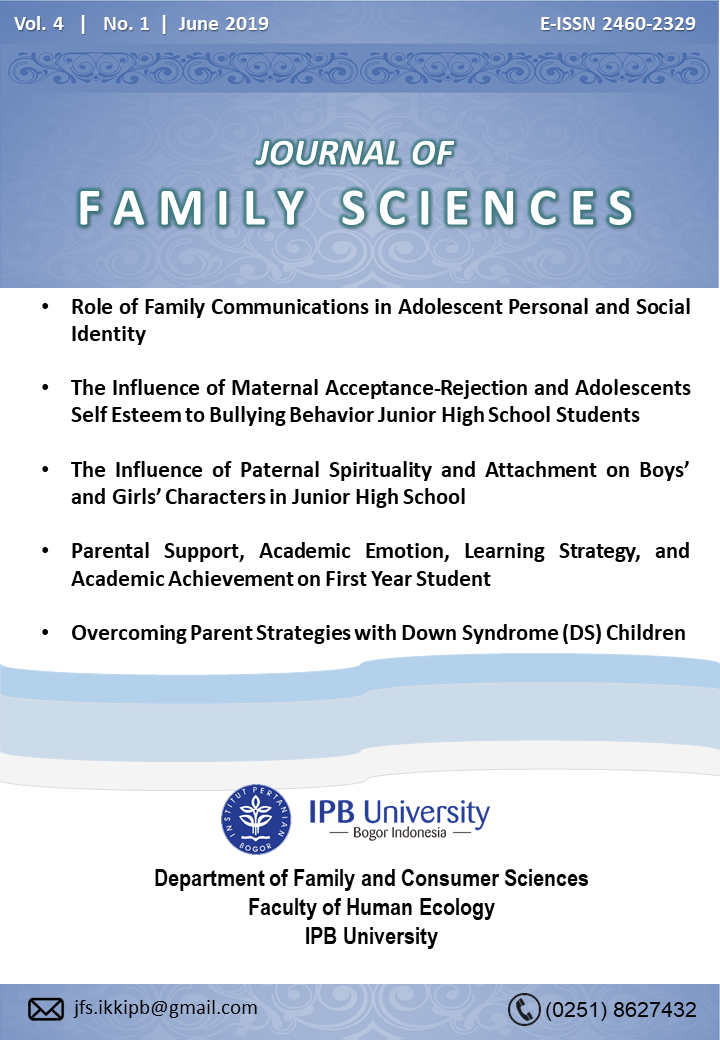Role of Family Communications in Adolescent Personal and Social Identity
Abstract
This study examines the relationship between family communication patterns (involving two dimensions of conversation and conformity) and the personal-social identity of adolescents. This study uses a survey technique involving 214 adolescents from intact families and single-parent families in one school in Bandung, by providing two scales of the Family Communication Pattern Revised (FCPR) from Ritchie and the scale of Social Identity-Personal Identity (SIPI) from Nario-Redmond. Data analysis to test three hypotheses in this study using Pearson product-moment correlation and regression analysis to find moderation of the measured variables. The findings indicate that the dimensions of the conversation are significantly positively related to social identity and personal identity. While the dimensions of conformity are negatively associated with social identity and positively associated with personal identity. After controlling for family status and sibling position in the family, the dimensions of conformity moderate significantly positive relationships between dimensions of conversation and social identity.Downloads
References
Aiken, L. S., & West, S. G. (1991). Multiple regression: Testing and interpreting interactions. Newbury Park, CA: Sage
Chickering, A. W. & Reisser, L. (1993). Education and identity. 2nd ed. San Francisco: Jossey Bass.
Erikson, E. H. (1980). Identity and the life cycle: A reissue. New York: Norton
Feinberg, M. E., Kan, M. L., & Hetherington, E. M. (2007). The longitudinal influence of co-parenting conflict on parental negativity and adolescent maladjustment. Journal of Marriage and Family, 69, 687–702
Josselson, R.L. (1994). Identity and relatedness in the life cycle. In H.A. Bosma, D.J.de Levita, T.L.J. Grastina& H.D. Grotevant eds. Identity and Development: An Interdisciplinary Approach. Thousand Oaks, CA: Sage, pp.81-102
Koerner, A. F., & Cvancara, K. E. (2002). The influence of conformity orientation on communication patterns in family conversations. The Journal of Family Communication, 2, 133–152. doi:10.1207/S15327698JFC0203_2
Koerner, A. F., & Fitzpatrick, M. A. (2002a). Toward a theory of family communication. Communication Theory, 12, 70–91. doi:10.1111/j.1468-2885.2002.tb00260.x
Koerner, A. F., & Fitzpatrick, M. A. (2002b). Understanding family communication patterns and family functioning: The roles of conversation orientation and conformity orientation. Communication Yearbook, 26, 36–68. doi:10.1207/s15567419cy2601_2
Koerner, A. F., & Fitzpatrick, M. A. (2002c). You never leave your family in a fight: The impact of family of origin on conflict-behavior in romantic relationships. Communication Studies, 53, 234–251. doi:10.1080/10510970209388588
Koerner, A. F., & Schrodt, P. (2014). An introduction to the special issue on family communication patterns theory. Journal of Family Communication, 14, 1–15. doi:10.1080/ 15267431.2013.857328
Little, T. D., Card, N. A., Bovaird, J. A., Preacher, K., & Crandall, C. S. (2007). Structural equation modeling of mediation and moderation with contextual factors. In T. D. Little, J. A. Bovaird, & N. A. Card (Eds.), Modeling contextual effects in longitudinal studies (pp. 207–230). Mahwah, NJ: Erlbaum
Marcia, J. E. (1998). Optimal development from an Eriksonian perspective. In Encyclopedia of Mental Health Vol. 3 (pp. 29–39). San Diego, CA: Academic.
Marcia, J. E., 1966. Development and validation of ego identity statuses. Journal of personality and social psychology. 3(5), pp. 551-558
Marcia, J.E (2002) Adolescence, Identity, and the Bernardone Family, Identity: An International Journal of Theory and Research, 2:3,199-209
McDonald D.G & Kim H . (2001). When I Die, I Feel Small: Electronic Game Characters and the Social Self. Journal of Broadcasting & Electronic Media, 45(2), pp. 241-258.
Nario-Redmond, MR, Biernat.M, Eidelman.S, & Palenske, D. (2004). The Social and Personal Identities Scale: A Measure of the Differential Importance Ascribed to Social and Personal Self-Categorizations. Self and Identity. 3. pp 143-175
Newcomb, T. M. (1953). An approach to the study of communicative acts. Psychological Review, 60, 393–404. doi:10.1037/h0063098
Newman, B. M., P. R. Newman, 2001. Group Identity and Alienation: Giving the We Its Due. Journal of Youth and Adolescence. 30 (5), pp. 515.
Ritchie, L. D. (1991). Family communication patterns: An epistemic analysis and conceptual reinterpretation. Communication Research, 18, 548–565. doi:10.1177/009365091018004005
Schrodt, P. (2005). Family communication schemata and the circumplex model of family functioning. Western Journal of Communication, 69, 359–376. doi:10.1080/10570310500305539
Schrodt, P., Ledbetter, A. M., Jernberg, K. A., Larson, L., Brown, N., & Glonek, K. (2009). Family communication patterns as mediators of communication competence in the parent-child relationship. Journal of Social and Personal Relationships, 26, 853–874. doi:10.1177/ 0265407509345649
Schrodt, P., Witt, P. L., & Messersmith, A. S. (2008). A meta-analytical review of family communication patterns and their associations with information processing, behavioral, and psychosocial outcomes. Communication Monographs, 75, 248–269. doi:10.1080/03637750802256318
Schrodt, P., & Shimkowski, J. R. (2015). Family Communication Patterns and Perceptions of Coparental Communication. Communication Reports, 30(1), 39–50. doi:10.1080/08934215.2015.1111400
Stringer, S. A. (1997). Conflict and Connection: The Psychology of Young Adult Literature. Portsmouth, Boynton: Cook Publishers, Inc
Authors who publish with this journal agree to the following terms:
- Authors retain copyright and grant the journal right of first publication with the work simultaneously licensed under a Creative Commons Attribution 4.0 International License that allows others to share the work with an acknowledgement of the work's authorship and initial publication in this journal.
- Authors are able to enter into separate, additional contractual arrangements for the non-exclusive distribution of the journal's published version of the work (e.g., post it to an institutional repository or publish it in a book), with an acknowledgement of its initial publication in this journal.
- Authors are permitted and encouraged to post their work online (e.g., in institutional repositories or on their website) prior to and during the submission process, as it can lead to productive exchanges, as well as earlier and greater citation of published work (See The Effect of Open Access).



_001.png)



